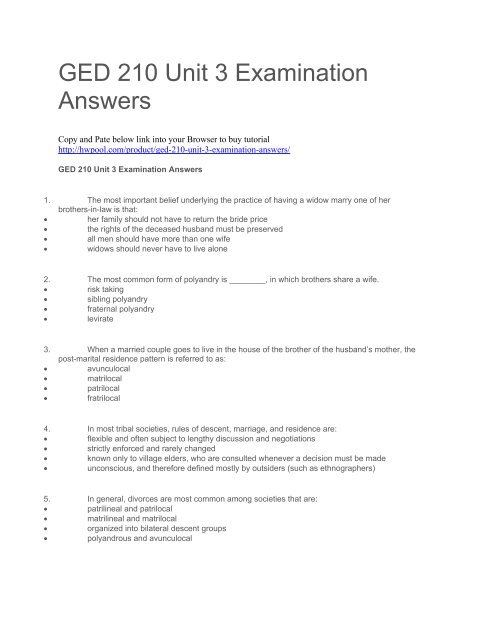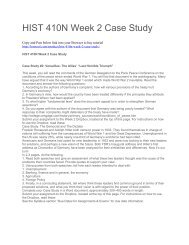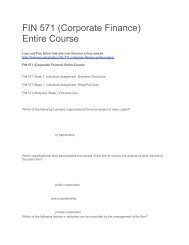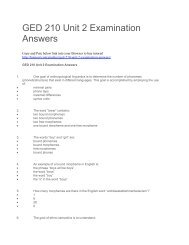GED 210 Unit 3 Examination Answers
You also want an ePaper? Increase the reach of your titles
YUMPU automatically turns print PDFs into web optimized ePapers that Google loves.
<strong>GED</strong> <strong>210</strong> <strong>Unit</strong> 3 <strong>Examination</strong><br />
<strong>Answers</strong><br />
Copy and Pate below link into your Browser to buy tutorial<br />
http://hwpool.com/product/ged-<strong>210</strong>-unit-3-examination-answers/<br />
<strong>GED</strong> <strong>210</strong> <strong>Unit</strong> 3 <strong>Examination</strong> <strong>Answers</strong><br />
1. The most important belief underlying the practice of having a widow marry one of her<br />
brothers-in-law is that:<br />
her family should not have to return the bride price<br />
the rights of the deceased husband must be preserved<br />
all men should have more than one wife<br />
widows should never have to live alone<br />
2. The most common form of polyandry is ________, in which brothers share a wife.<br />
risk taking<br />
sibling polyandry<br />
fraternal polyandry<br />
levirate<br />
3. When a married couple goes to live in the house of the brother of the husband’s mother, the<br />
post-marital residence pattern is referred to as:<br />
avunculocal<br />
matrilocal<br />
patrilocal<br />
fratrilocal<br />
4. In most tribal societies, rules of descent, marriage, and residence are:<br />
flexible and often subject to lengthy discussion and negotiations<br />
strictly enforced and rarely changed<br />
known only to village elders, who are consulted whenever a decision must be made<br />
unconscious, and therefore defined mostly by outsiders (such as ethnographers)<br />
5. In general, divorces are most common among societies that are:<br />
patrilineal and patrilocal<br />
matrilineal and matrilocal<br />
organized into bilateral descent groups<br />
polyandrous and avunculocal
6. Deborah Gewertz, who has re-examined Mead’s interpretations of the Tchambuli (Chambri),<br />
arrived at the conclusion that:<br />
Chambri women are among the most aggressive in all human societies<br />
Mead’s interpretations failed to take specific historical circumstances into account<br />
Chambri men were submissive due to frequent defeats in warfare<br />
cultural values do not influence gender roles<br />
7. The Kula, described by Malinowski in Argonauts of the Pacific, refers to:<br />
a type of outrigger canoe used for long-distance travel by island chiefs<br />
a ceremonial dance performed by the indigenous Hawaiians<br />
a ritual in which red shell necklaces were traded for white armbands<br />
a sacred beverage whose use was restricted to Tahitian chiefs<br />
8. The Kula is an example of what type of exchange?<br />
redistribution<br />
balanced reciprocity<br />
hypergamy<br />
market exchange<br />
9. The term “barter” is used to refer to:<br />
the agreement on a certain price for a specified product<br />
a system of unbalanced reciprocity in which goods of unequal value are exchanged<br />
the direct exchange of one commodity for another<br />
the redistribution of goods in a marketplace<br />
10. The potlatch feasts of the northwest coast societies are usually interpreted as a form of:<br />
long-distance barter<br />
resource conservation<br />
ritualized warfare<br />
redistributional exchange<br />
11. Which of the following might be interpreted as a modern example of the potlatch?<br />
A local politician gives away hundreds of frozen turkeys at a campaign rally.<br />
A special interest group pays the salary and expenses of a lobbyist.<br />
A former president makes speeches in favor of his party’s new candidate.<br />
Delegates at a national convention trade buttons and other campaign memorabilia<br />
12. A major difference between redistributional and reciprocal economies is that:<br />
reciprocal economies are more common in societies with inequalities in social status<br />
redistributional economies tend to make certain individuals wealthier than others<br />
reciprocal economies always involve the exchange of a recognized form of currency<br />
only redistributional economies involve transfers of goods among related villagers
13. From a cross-cultural study, Jack Goody learned that bridewealth occurs more frequently in<br />
horticultural societies, whereas the dowry system is most frequently found in agricultural states. He<br />
further hypothesized that one function of the dowry system was to:<br />
consolidate property in the hands of elite groups, thus increasing their wealth and status<br />
spread wealth out over a larger area so that everyone in the society had about the same level<br />
of affluence<br />
counteract the practice of bridewealth, non-adaptive in an agricultural state, because it<br />
allowed certain families to accumulate too much wealth by selling their daughters to the highest bidder<br />
create an egalitarian society<br />
14. Since wealth and status determine the type of marriage patterns found in agricultural states,<br />
the primary form of marriage for all but the elite was:<br />
polygyny<br />
polyandry<br />
polygamy<br />
monogamy<br />
15. Monogamy is the primary form of marriage in most agricultural states. The probable reason<br />
this pattern is so prevalent is:<br />
most agricultural states have laws against polygamous marriages of any kind becausethey<br />
disrupt the normal flow of the agricultural cycle<br />
in agricultural societies, where land is a scarce commodity, peasants cannot afford the luxury<br />
of polygyny<br />
polygyny is impossible because there are fewer women than men in agricultural states<br />
most peasants can only afford to accumulate enough wealth for one dowry<br />
16. Divorce was rare in agricultural states because of a number of factors. Which of the following<br />
is not one of the factors discussed in the text?<br />
Both the corporate character of the extended family and the necessity for cooperative labor<br />
among family members usually lead to normative constraints against divorce.<br />
Marriage was the most important way that land was transferred, and marriages were the basis<br />
of alliances between families and kin groups.<br />
In some societies, marriage became a sacred institution and there were laws againstdivorce.<br />
Divorce was not allowed in many, if not all, agricultural states because of the emotional<br />
disruption it caused to the family members, often making them unfit for agricultural labor.<br />
17. In many agricultural states, women were restricted to domestic activities while men were<br />
permitted to engage in public (outside) endeavors. Women were often not allowed to own property,<br />
engage in politics, or pursue educational goals. These restrictions were reflected in a number of<br />
cultural practices such as:<br />
purdah and foot binding<br />
caste system<br />
idiographic mediation<br />
dowry and bridewealth<br />
18. Social inequality is exemplified in the __________ of Indi These social units are endogamous<br />
groupings into which a person is born and dies.<br />
purdah system
shogun scheme<br />
caste system<br />
slavery system<br />
19. Capitalist societies share three basic ideals. Which of the following is NOT one of these<br />
ideals?<br />
The elements of production are privately owned<br />
Companies are free to maximize profits and accumulate wealth.<br />
Land and resources should be owned and controlled by the state government, while<br />
production and services are in the hands of free enterprise.<br />
Free competition and consumer independence are basic to all economic activities.<br />
20. Anthropologists have found that kinship in industrial states:<br />
often becomes solidified and molded into large descent groups called oligoclans<br />
becomes much more important and clearly defined than in preindustrial societies<br />
becomes less important as new structures and organizations replace and begin to perform<br />
many of the functions associated with kinship in preindustrial societies<br />
tends to remain about the same as is found in chiefdom societies<br />
21. With industrialization, the functions of the family changed, and one of the major<br />
transformations was the:<br />
increase in the frequency of polyandrous marriages, especially those involving brothers<br />
decrease in the mobility of members of the family since they were all tied to industrial<br />
production<br />
increase in matrilocal residence and a reduction in patrilocal residence<br />
diminishing importance of the extended family and the emergence of the nuclear family<br />
22. As nuclear families replace extended families in industrial societies, older people no longer<br />
reside with their adult children. The role of the elderly in retaining and disseminating information has<br />
diminished in industrial societies. The elderly have lost much of their economic power. Sociologist<br />
Donald O. Cowgill has hypothesized that:<br />
The status and role of the elderly in the future will increase because the birthrate has dropped<br />
to an all-time low.<br />
There will be an elderly revolution, termed the “silver-haired rebellion,” which will place much<br />
of the lost power and status back into the hands of the older segment of society.<br />
As the rate of technological change accelerates, knowledge quickly becomes obsolete, and<br />
this decreases the status and role of the elderly (they are no longer the storage houses of<br />
technological knowledge; libraries and databanks have taken over this role).<br />
In the future, there will be a major reorganization of kinship and the family, which will restore<br />
power to the elderly.<br />
23. Chiefdoms and agricultural states are classified as __________ because they provide little<br />
opportunity for social mobility. Industrial states, on the other hand, are considered ___________<br />
because social status can be achieved through individual effort.<br />
oppressive; free<br />
hierarchical; egalitarian<br />
closed societies; open societies<br />
caste cultures; kindred cultures
24. The House of Lords in Great Britain differs from the House of Commons because membership<br />
in the House of Lords is:<br />
based on intellect<br />
inherited through families<br />
limited to those individuals who have already served in the house of commons<br />
based on religious affiliation and achieved status<br />
25. The primary mode of social mobility in Japanese society is:<br />
education<br />
luck<br />
inheritance<br />
what is called burakumin and eta

















